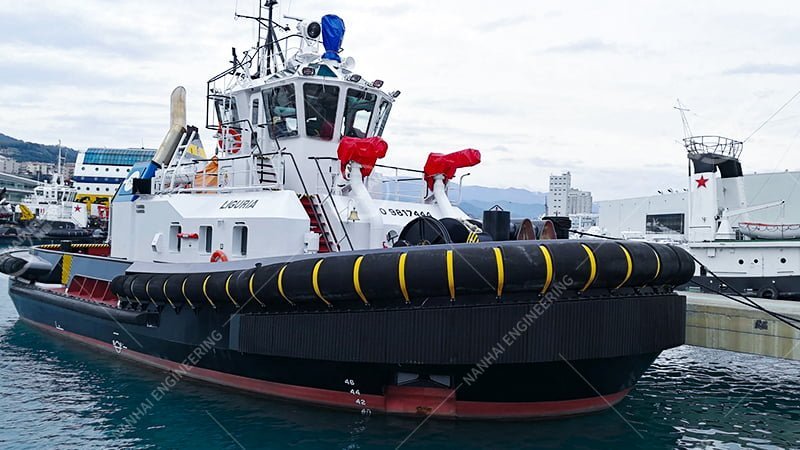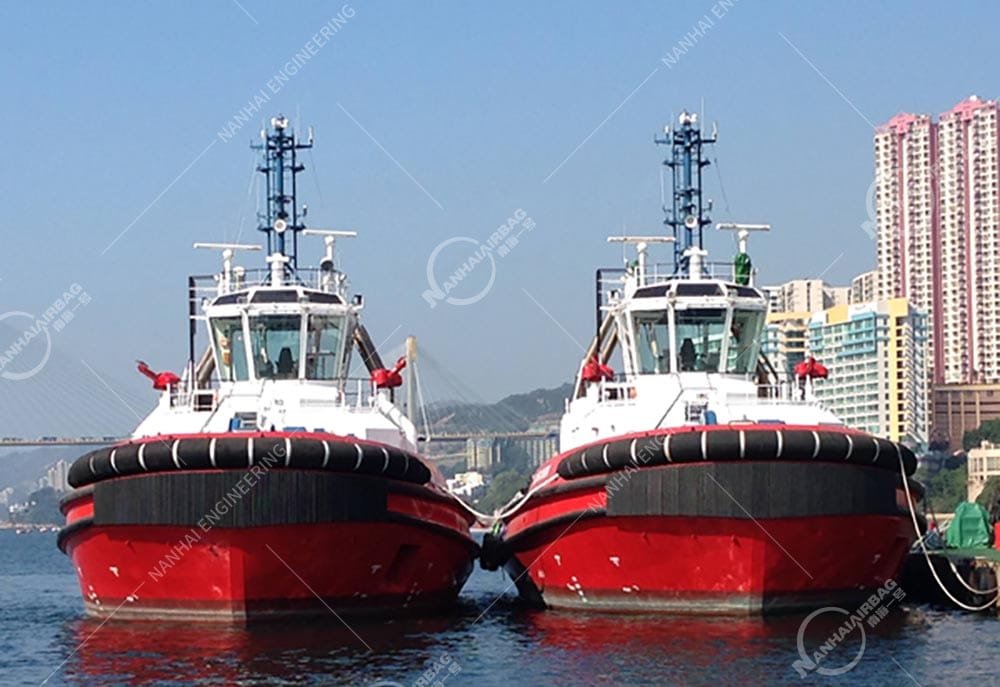The world’s top ten busiest ports
07/30/2025What are the air bags for salvage boats?
07/30/2025What is the purpose of tugboats?
Introduction
Tugboats may look small, but they play a big role in ports and at sea. These powerful vessels push and pull much larger ships, helping them move safely through tight areas like harbors and channels. In this article, we’ll break down what tugboats are, what they do, and why they matter so much to modern shipping.

What Is a Tugboat and How Does It Work?
A tugboat (or simply “tug”) is a small, strong boat designed to assist other vessels by pushing or towing them. Tugboats have powerful engines and high “bollard pull,” which means they can move or hold large ships steady even in strong winds or currents.
They often connect to the ships they assist using ropes (tow lines), or by pushing directly with their hulls. Because of their tough jobs, tugboats are built strong and have rubber fenders to absorb shock.

Main Functions of Tugboats
1. Harbor Assistance
Tugboats help large cargo ships, cruise liners, and tankers move in and out of ports. These big ships can’t easily maneuver at low speed or in tight spaces, so tugboats help them turn, dock, or undock safely.
Tugboats reduce the risk of crashing into docks or other vessels. That’s why they are essential in busy ports and narrow waterways.
2. Towing and Pushing Operations
Tugboats tow floating platforms, barges, or ships that can’t move on their own. They can pull from a distance using strong tow lines or push directly with their bow.
In some jobs, tugs line up behind or alongside large structures and push them to the correct location. These operations often involve close contact, which is why tugboats need good fenders.
3. Emergency Rescue and Salvage
Some tugboats are built for emergency situations. They rescue ships that are stranded, drifting, or on fire. These “salvage tugs” carry tools for firefighting, patching leaks, and pumping out water.
They’re vital during oil spills, maritime accidents, or severe storms. Tugboats are often the first responders at sea.
4. Escort and Channel Guidance
Escort tugboats guide large or dangerous cargo vessels through narrow or tricky channels. For example, oil tankers may be followed by one or two tugs during their entire approach or departure from port.
These tugs can quickly react if the big ship veers off course, helping to avoid accidents. A recent example was the Baltimore bridge collapse—experts say proper tug escort might have helped prevent it.
5. Icebreaking and Special Missions
Some tugboats operate in icy waters. These icebreaking tugs break frozen paths so other ships can pass through.
Others perform unique tasks like setting up floating construction equipment or supplying offshore platforms. Tugboats can be adapted for many different roles depending on the mission.
6. Firefighting and Ceremony Use
Many tugboats have powerful water cannons. These help fight fires at sea or in port. They also cool ship engines and clean salt from hulls.
Sometimes, tugboats even take part in harbor shows or celebrations by spraying water into the air.
Types of Tugboats (Expanded)
Tugboats come in many forms. Each type serves a special job, and most are equipped with tugboat fenders—strong rubber systems that protect both the tug and the ships they assist.
1. Harbor Tugs
These compact and agile tugboats work inside ports. They help large ships dock, turn, or leave tight spaces. Most harbor tugs use 360° azimuth thrusters for high maneuverability.
Tugboat fenders: Harbor tugs often use bow-mounted cylindrical or drum-shaped fenders. These absorb the impact during close pushing operations.
2. Seagoing / Ocean Tugs
These tugs are built for long-distance towing. They tow oil rigs, damaged ships, and large cargo units across the ocean.
Tugboat fenders: Seagoing tugs usually install heavy-duty foam-filled or block-type fenders on the sides and rear to protect the hull during open-water work.
3. River Tugs / Inland Tugs
These are flat-bottomed tugs used in rivers and lakes. They often push barges carrying goods like grain or coal.
Tugboat fenders: River tugs frequently use M/W-shaped fenders on the bow. These absorb the repeated impacts of pushing barges.
4. Salvage Tugs
These specialized tugs respond to emergencies like shipwrecks or fires. They carry tools for repair, rescue, and recovery.
Tugboat fenders: These tugs need multi-purpose fenders that handle impact, heat, and pressure during tough rescue operations.
5. Escort Tugs
Escort tugs guide high-risk ships like LNG carriers or tankers. They follow closely and can help slow or steer the vessel if needed.
Tugboat fenders: These tugs use strong, energy-absorbing cylindrical bow fenders and side fenders to reduce damage during close escort maneuvers.
6. Multi-Purpose Tugs
These tugs can do many jobs—docking, towing, firefighting, supply delivery, and more.
Tugboat fenders: They often use modular fenders that can be swapped out depending on the mission.
Key Technologies and Performance
- Bollard Pull: This measures how much force a tug can exert when towing. Modern harbor tugs often exceed 60 tons of bollard pull.
- Propulsion Systems: Tugboats use propeller systems like azimuth drives, Kort nozzles, or Voith cycloidal drives for better maneuvering.
- Power: Most tugs run on diesel, but hybrid and electric models are now emerging for greener performance.
Tugboats and Safety
Tugboats are essential for preventing accidents, especially in crowded ports and tricky waterways.
In the Baltimore bridge collapse, the cargo ship had no tug escort when it lost control. Some experts believe tugboats could have helped avoid the disaster.
Industry Trends
- More power: Ships are getting bigger, so tugs must get stronger.
- More escort rules: Ports may soon require mandatory tug assistance for large or risky vessels.
- Greener designs: Electric, hybrid, and LNG-powered tugs are becoming more common.
- Smarter tech: Some new tugs use remote-control systems and real-time navigation tools.
Conclusion
Tugboats do much more than push and pull ships—they keep global trade moving safely and efficiently. From harbors to high seas, they support docking, rescue, towing, escort, and even fire control.
With better engines, smarter tech, and strong tugboat fenders, these small giants will keep playing a big part in maritime operations for years to come.
FAQ
Q1: How much does tugboat service cost?
It depends on the ship size, service time, and port. Some major tug services can cost thousands of dollars per trip.
Q2: Do tugboat crews need a license?
Yes. Tugboat captains and crew must follow strict marine safety and licensing rules, depending on the country.
Q3: What’s the difference between a tugboat and a towboat?
In most cases, they mean the same thing. “Tugboat” is used at sea and in ports, while “towboat” is more common on rivers.
